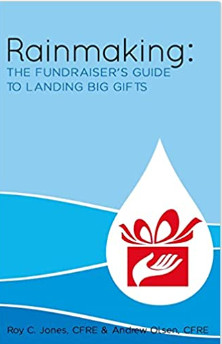In today’s down economy, it’s even more critical to not miss an opportunity to ramp up your fund development program. To that end, here are 50 possible improvements to your fund development programs. Special thanks to Pamela Barden and Fundraising Success Magazine…
General fundraising
1. Question everything. Are you doing it because it makes you (or a board member) feel good and not because it raises money? Now is the time to make tough calls and eliminate things that drain your budget without increasing income.
2. Offer choices when donors say, “You mail too much!” Have step-down options — rather than “all or nothing” — that reduce direct mail to quarterly, semiannually or annually. Be sure to schedule when to contact donors with mail restrictions, so they aren’t forgotten. In my last position as a development director we had 57 combinations of mail suppression codes and not a single “do not mail”.
3. Test everything — including what you read in this article — and only make changes that improve net income. Don’t simply react to the economy, or change because “everyone else is doing it.”
4. Call and thank former monthly donors: just saying a simple “thank you for all you’ve done” can encourage former donors to start giving again.16. For gifts larger than a predetermined level, mail a very personal, closed-face letter one week after the receipt to reaffirm your gratitude. Don’t include any reply device. You’re strengthening the relationship; additional giving will follow.
Newsletters
5. Look for untapped opportunities: direct mail should be your core source of income, with radio, TV, face-to-face, planned giving and online fundraising bringing in the balance.
6. Acknowledge milestones. Call and thank donors who give over a number of years or reach a certain accumulated giving threshold. Showing genuine appreciation is an unbeatable retention strategy.
7. Look for your trouble spots, and develop strategies to address them. For example, when are ongoing donors most likely to stop giving? At one organization we work with, it was after three years of giving, so we began a recognition program at that point and saw amazing improvement in retention.
8. If you rely on premiums for donations, think continuity. A desire to receive the entire series can encourage ongoing giving.
9. When donors call, start building a relationship, let them tell you the reason they called.
10. When you make a mistake that affects donors, the best strategy for dealing with it is to simply say, “I’m sorry.” For example, a nonprofit I support double-charged a donation to my bank account: the woman I spoke to was so genuinely sorry I told her to keep the extra gift.
Receipts
11. Get receipts out quickly — in hours, not days or weeks. Donors want to be assured you received their gifts, you’re using them wisely and you’re grateful. I have tested response rates in my acknowledgement letters…. the number donors who send a second gift can be as high as 20% if thanked the same day… with each day you delay thanking a donor, response rates will drop by 2%. If you wait longer than a week to 10 days you will rarely recieve additional gifts from the thank you mail. A good acknowledgement program always pays for itself. Most programs net cash.
12. Write custom copy for first-time donors, special offers and major programs, if possible. “One size fits all” seldom works for T-shirts or receipt copy.
13. Don’t let donor remorse set in: include stories that show how effective you are in using donations.
14. Encourage repeat giving by enclosing an easy-to-use coupon and a return envelope. A three-part receipt — letter, receipt and return form — is a proven strategy for increasing additional gifts.
15. Make the best use of your first-class postage costs by adding inserts on giving opportunities, planned giving, special events, etc.
17. In each article, show how you achieved results, but gently remind the reader that the job is not yet done, and you still need her help.
18. Repeat those opportunities on the reply form so it’s easy for the donor to designate a gift to meet each specific need.
19. Put your newsletter in an envelope with a loose reply form and reply envelope; the extra cost usually is much less than the additional income you’ll receive. The good newsletter will only produce about half the income of your regular donor mail. However, without a newsletter your regular donor income will drop in half.
20. Save money without sacrificing quality or interest. For example, a No. 10 envelope with a large window on the non-address side allows you to use the same envelope for every issue and creates interest when a compelling photo shows through.
21. Survey donors to find out which regular articles they enjoy. Eliminate the ones that aren’t popular, and use the space for articles that better resonate with your audience.
Direct mail
22. Test frequency: don’t let donors forget you. You probably can add a mailing (or two) and net more dollars.
23. Nothing says “junk mail” quite like indicia. Test a live, bulk-rate stamp; it adds only a small amount to your production costs, but could significantly lift response and net income. For higher-end donors, test a first-class commemorative stamp.
24. Develop a monthly giving program; donors who are committed to give monthly are your most loyal donors and usually stay with you, even in tough economic times.
25. Reuse winning packages. Donors don’t remember the appeals you sent a year ago. Freshen up the copy as needed.
26. The outer envelope serves two purposes: to hold the contents together and to induce the donor to open and read the appeal. Teasers, closed-face, live stamps, four-color, and hand-addressing all work sometimes, but not always. Test!
Major donors
27. Be sure you aren’t neglecting your major donors. Too often, they are moved out of the direct-mail file for “special treatment” that never really happens.
28. Rethink donor clubs. Don’t hesitate to cancel them if they aren’t improving net income. Reabsorb the members into your main mailstream, but honor their commitment with closed-face envelopes, personal letters, etc.
29. NEVER completely remove major donors from your direct mail program. Find the contact methodology that meets the donor’s needs and is most likely to result in continued partnership. For example, a major donor to an organization we work with sent $50,000 every January when she received the direct-mail piece with a matching-grant offer. Instead of a visit, the representative started calling her to give her a “heads-up” that the mailing was on the way.
30. Promote planned giving in your receipts. A simple insert can spark interest and bring in leads.
Planned giving
31. Ask participants for endorsements you can print. We all like additional confirmation from people just like us.
32. Test before including planned-giving messages in fundraising appeals. Sending mixed messages could hurt response.
New donors
33. Thank them with special receipts. Be as warm and welcoming as possible, and reaffirm that supporting you was a wise decision.34. If possible, have a separate welcome mailing. It’s another opportunity to say “thank you” and provide
35. Consider a small, mission-appropriate premium (a bookmark, for example) for donors who give second gifts within 60 days. Promote this with a small insert in the first receipt.
36. Receipt the first gift, no matter how small.
37. At a predetermined threshold, call just to say “thank you.”
Lapsed donors
38. Test sending a postcard with a special need. Make the front of it colorful and exciting. Drive responses online or to a toll-free number.
39. Survey to find out why they stopped giving. Use the information to improve your program.
40. Be aggressive; start re-upping before they lapse. Calls and letters reminding them it’s been almost a year since they last gave are proven ways to keep donors from lapsing.
41. Monitor the results of all lapsed efforts, and know when to stop. At some point, move them into an acquisition-only file.
Acquisition
42. Love your control. No one else is bored with it. Don’t discard it unless it’s no longer working and you have something else consistently working better.
43. Test a variety of outer envelopes with the same package content. If your envelope isn’t getting
44. Mail acquisitions to your prospects and deeply lapsed donors. It’s a low-cost way to activate them.
45. If you rent lists, remail the names that show up on multiple lists (with permission from the list owners) a few weeks later. These are usually the most responsive names.
46. Have one person — with solid fundraising experience — own your total e-mail experience. Don’t let everyone in the company dictate when and what to e-mail.
Online
47. Avoid the temptation to over-e-mail. If your e-mails start to feel like spam, you’ll become a permanent resident of the “deleted items” file.
48. Maximize your Web site for search engines; learn how by going online and searching for “SEO” and “SEM.”
49. Promote reasons to go to your Web site in your newsletters, receipts and other communications.
50. Make sure online giving is secure, easy to find and easy to use. Printing and mailing a form is not a substitute for secure online giving.
In good times or bad, always be looking for leaks you can plug. Several small improvements in your fundraising program can add up to significantly more net income — and greater opportunities to carry out your important work.


